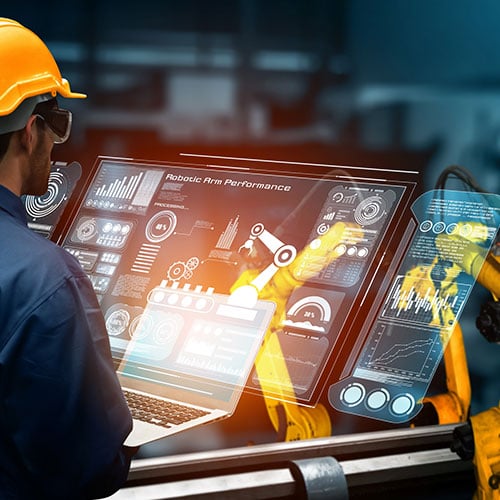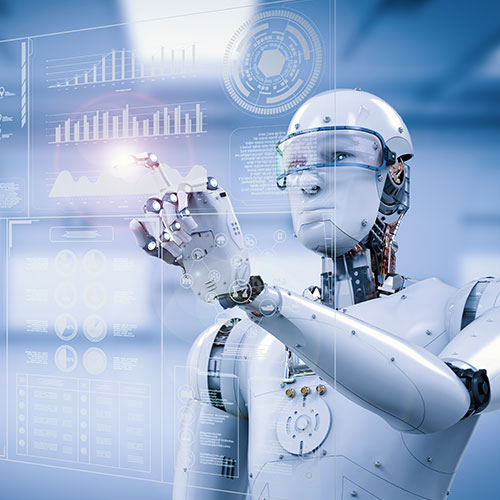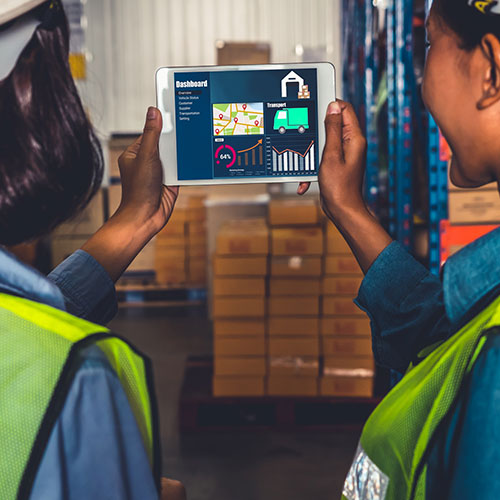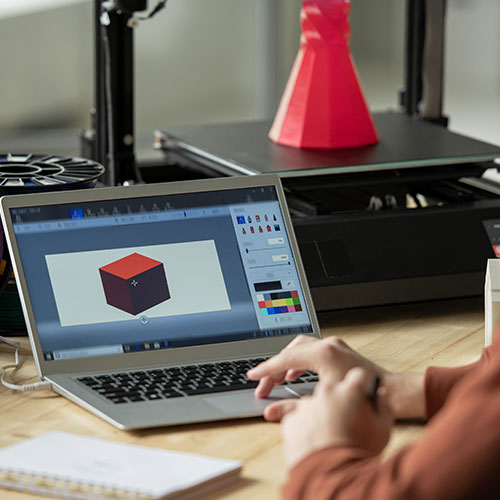The manufacturing industry is erupting in digital transformation, much like every other industry. Company decision-makers are seeing the benefits of digital transformation services, including:
- Sustainability
- Enhanced data collection
- Increased profits
- Increased agility
- Greater resource management
- Better customer insights and experience
- Significant economic impact
- Improved productivity
Additionally, manufacturing companies are trying to keep up with the demands of consumers, who want high-quality products and responsible manufacturing practices. To do that, companies must adopt data-driven technology and evolve with the digital trend knows as Industry 4.0. But first, they must acquire the infrastructure necessary to engage with several of these technologies.

AI (Artificial Intelligence)
There are many types of AI, several of which transform traditional businesses into more digitally literate ones. One example in the manufacturing industry is intelligent workplace automation, which can be applied in various ways, such as:
- Product development
- Shop floor performance improvement
- Predictive maintenance
- Price forecasting
- Edge analytics
- Inventory management
- Design customization
- Logistics optimization
- Generative design
- Robotics
- Quality assurance
- Process optimization
Using AI in manufacturing can lead to many benefits, including:
- Increased safety
- Cost reduction
- More production time
- Faster decision-making
Understanding the types of AI is an important step in knowing how to implement it in the workplace. Let's take a deeper look at automation.

Automation
Automation consists of technology, programs, and robotics to achieve outcomes that have little to no human input. Basically, automation can help companies perform tedious tasks without human error. There are many benefits that manufacturing companies can take advantage of like:
- Increasing production
- Improving quality
- Creating a safer workplace
- Reducing cycle times
- Reducing manufacturing lead times
- Becoming more competitive
Some examples of automation in manufacturing include:
- Mechanized assembly
- Machining transfer lines
- Automated material handling
- Computer numerical controlled machine tools
- Industrial robots
- Programmable logic controllers
All in all, automation can help streamline the manufacturing process, helping companies make decisions faster and gain a competitive edge.
Predictive Analytics
Predictive analytics uses data, statistical algorithms, and machine learning to identify the likelihood of future events. It leverages historical data to predict what will happen in a company's future. This, along with other types of analytics, provides multiple benefits for the manufacturing industry. For example, it can help determine the likelihood of mechanical breakdowns, which enables manufacturers to schedule maintenance. Additionally, companies can limit or prevent any impact on the production pipeline.

Real-time Monitoring
Real-time monitoring allows companies to keep an eye on any glitches or other problems within a site or their company, enabling quick responses. This can help prevent production bottlenecks and helps companies meet customer delivery dates. Real-time monitoring can also:
- Increasing production
- Improving quality
- Creating a safer workplace
- Reducing cycle times
- Reducing manufacturing lead times
- Becoming more competitive
Understanding how real-time monitoring works can help manufacturers cut down on common business struggles like downtime, equipment efficiency, and logistics management. Additionally, companies can take advantage of the benefits, like operational efficiency, improved accountability, and reduction in operational cost.

3D Printing
3D printing produces physical, three-dimensional objects from a digital model by repeatedly adding a layer of material on top of other layers of material until the object is completed. These printers do not require extra tools, which is an added benefit. Other advantages include:
- Customization of parts
- Low-cost prototyping
- Low start-up costs
- Quick turnaround
- A large range of specialty materials to work with
Manufacturing companies are taking advantage of these benefits by applying 3D printing to their own businesses. For instance, research and development teams are able to create prototypes while saving time and money, since they only need one tool (the printer) and one type of material. Additionally, 3D printing is good for the environment because it uses fewer materials, creates less waste, and does not require transportation. This can help manufacturing companies lower their carbon emissions.
AR and VR
Augmented reality (AR) and virtual reality (VR) are two of the biggest technology trends in manufacturing and many other industries. AR is the rendering of digital images onto the real world. For instance, Amazon allows people to look at furniture in their space through their phone app. VR, on the other hand, is a simulated experience, much like being put in the middle of a video game. Both, however, are having a huge impact on the manufacturing industry.

AR
for example, can help:
- Engineers improve accuracy by showing them renderings of parts and where they should go
- Employees address daily problems with maintenance teams and engineers
- Technicians repair machines through the use of AR-enabled apps that allow them to view interior images

VR
can help manufacturers by:
- Allowing companies to test products before producing them, in turn creating better products
- Improving worker safety by simulating the production line and accounting for dangers
- Letting companies put together products in a virtual world, saving money on testing and prototypes
Companies can use both AR and VR for more accurate training as well.
While VR and AR are already making a dramatic difference, these tools will continue to improve. Manufacturing companies can take advantage of these lasting benefits for years to come.
The Industrial Internet of Things
The Industrial Internet of Things (IIoT) consists of billions of industrial devices that are embedded with sensors. These sensors are connected to wireless networks to gather and share data. The IIoT can help a manufacturer make faster and better decisions about their business because it can provide data in real-time — which helps them better understand their business. Additionally, the IIoT makes supply chains more interconnected, which promotes efficiency and safety, and saves money. For instance, the IIoT can:
By adopting IIoT solutions, manufacturers can be more informed about every aspect of their business, from employee safety and production, to maintenance.
The manufacturing industry recognizes the benefits of digital transformation. By leveraging new technology like AI, VR, AR, 3D printing, and IIoT, manufacturers can gain a competitive advantage in their industry.
Experience the Trianz Difference
Powered by knowledge, research, and perspectives, we enable clients to transform their business ecosystems and achieve superior performance by leveraging infrastructure, cloud, analytics, digital, and security paradigms. Reach out to get in touch or learn more.

